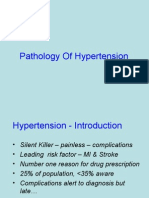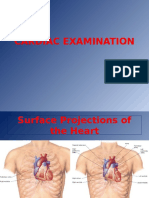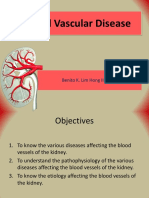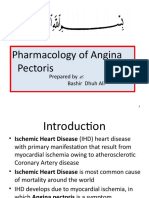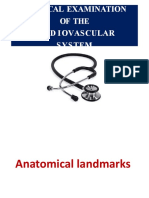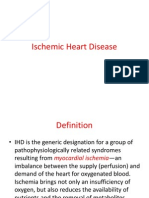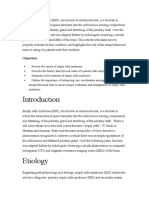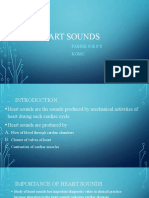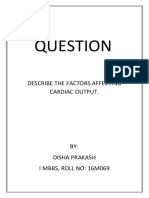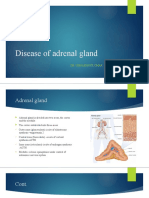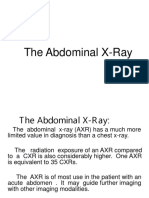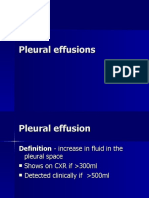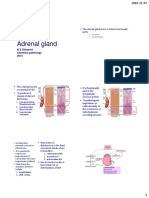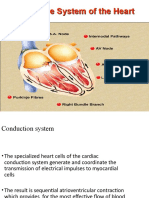Cardiac Tamponade Guideline
Cardiac Tamponade Guideline
Uploaded by
Prasant GanesenCopyright:
Available Formats
Cardiac Tamponade Guideline
Cardiac Tamponade Guideline
Uploaded by
Prasant GanesenCopyright
Available Formats
Share this document
Did you find this document useful?
Is this content inappropriate?
Copyright:
Available Formats
Cardiac Tamponade Guideline
Cardiac Tamponade Guideline
Uploaded by
Prasant GanesenCopyright:
Available Formats
Cardiac Tamponade
Cardiac Tamponade
Clinical signs
Pulsus paradoxus
It is an exaggerated drop (> 10mm Hg) in the systolic
arterial blood pressure upon inspiration.
** palpate the brachial or radial pulse maximally, slowly
decreasing your pressure on the pulse while watching the
patient breathe. If pulsus paradoxus is present, you will
get to a point where the pulse during inspiration decreases
or disappears, while it remains palpable during expiration.
Cardiac Tamponade
Clinical signs..
Pericardial friction rub may be present
Heart size on x-ray may be normal
or enlarged
Echocardiogram
Pericardial Tamponade
Note rounded bottle shape to left
side of heart
Compare with next 2 slides
Chest x-ray
Widened mediastinum
Pneumo- or hemothorax
Electrical alternans
Cardiac Tamponade
Pathophysiology
Impairment of ventricular diastolic filling caused by
pressure of pericardial sac
And by bulging of ventricular septum
into LV
Stroke volume and cardiac output fall
5
Pericardiocentesis
Indications
Immediate threat to life
Severe hemodynamic impairment
Fall in systolic blood pressure >30 mm Hg
Pericardiocentesis
General principles
As of 2000 = echocardiography used to
guide pericardiocentesis
Direct subxyphoid techniques only used in
dire medical emergency
ECG and hemodynamic monitoring
Full resuscitation equipment available
7
Pericardiocentesis
Equipment
16-gauge short-bevel large-bore needle
30- or 50-mL syringe
Echo- or ECG-guided (V lead)
Local anesthetic
Sterile supplies and povidone-iodine
solution
8
Pericardiocentesis
Technique
Patient in supine position, upper
torso elevated
ECG limb leads attached to patient
Use echocardiography guided procedure
(rarely: ECG-guided, V lead)
Subxiphoid approach
Continuous aspiration
9
Pericardiocentesis
For historical interest: ECG-guided
needle advancement
10
Pericardiocentesis
Hazards
Cardiac arrhythmias
Laceration of myocardium or
coronary arteries
Injection of air into cardiac chambers
Hydrothorax or pneumothorax
Hemorrhage from laceration may
produce tamponade
11
You might also like
- Lecture 29 - Pathology of HypertensionDocument24 pagesLecture 29 - Pathology of Hypertensionapi-3703352100% (6)
- Glomerular DiseasesDocument31 pagesGlomerular DiseasesLALITH SAI KNo ratings yet
- Pathology of The Lung: Djumadi AchmadDocument26 pagesPathology of The Lung: Djumadi AchmadVivi DeviyanaNo ratings yet
- Lecture 3. Bleeding Disorders Part 1Document31 pagesLecture 3. Bleeding Disorders Part 1Kekelwa Mutumwenu Snr100% (1)
- Cardiac ExaminationDocument23 pagesCardiac ExaminationAreza Eka PermanaNo ratings yet
- Acute Pulmonary Edema - NEJMDocument4 pagesAcute Pulmonary Edema - NEJMSuzika Dewi0% (1)
- Examining The PrecordiumDocument83 pagesExamining The PrecordiumnicolNo ratings yet
- Guidelines For Third-Year Students of The Medical DepartmentDocument9 pagesGuidelines For Third-Year Students of The Medical Departmenthealer sruthy100% (1)
- Hormones of The Adrenal Medulla For LabconDocument57 pagesHormones of The Adrenal Medulla For LabconnikkitingNo ratings yet
- Approach To Cardiac MurmursDocument11 pagesApproach To Cardiac Murmurstouthang0074085No ratings yet
- COPDDocument15 pagesCOPDlouirufi3003No ratings yet
- Patterns of RespirationDocument67 pagesPatterns of Respirationsteven hkNo ratings yet
- 3 Renal Vascular Disease 3Document46 pages3 Renal Vascular Disease 3Coy NuñezNo ratings yet
- Pharmacology of Angina Pectoris: Prepared by Bashir Dhuh AliDocument11 pagesPharmacology of Angina Pectoris: Prepared by Bashir Dhuh AliZakarie Abdullahi HusseinNo ratings yet
- CVS Lect 6 Blood Pressure, PathophysiologyDocument13 pagesCVS Lect 6 Blood Pressure, PathophysiologySherwan R Shal100% (5)
- Cvs PracticalDocument63 pagesCvs PracticalSreedeep TejaNo ratings yet
- Kidney TumorsDocument15 pagesKidney TumorsJose SirittNo ratings yet
- Ischemic Heart Disease 19.9.90Document27 pagesIschemic Heart Disease 19.9.90Hamidreza GoodarzynejadNo ratings yet
- General Examination For CVSDocument29 pagesGeneral Examination For CVSstudymedic100% (1)
- Action Potential of Cardiac MusclesDocument16 pagesAction Potential of Cardiac Muscleswaqas_xsNo ratings yet
- SyncopeDocument44 pagesSyncopeSap ModulesNo ratings yet
- Coronary Artery DiseaseDocument33 pagesCoronary Artery DiseaseAlma Rifa'Ana LiskaNo ratings yet
- Fluid and Electrolyte DisordersDocument47 pagesFluid and Electrolyte DisordersMarc Imhotep Cray, M.D.No ratings yet
- Arrhythmias and Conduction DisordersDocument23 pagesArrhythmias and Conduction Disordersxaalam easyNo ratings yet
- Endo 3 Notes PDFDocument9 pagesEndo 3 Notes PDFDilNo ratings yet
- Chapter 13 Drugs Used in Heart FailureDocument7 pagesChapter 13 Drugs Used in Heart FailureChristine Annmarie TapawanNo ratings yet
- Empty Sella SyndromeDocument21 pagesEmpty Sella SyndromeMohamed TarekNo ratings yet
- Pons MedullaDocument32 pagesPons MedullaEnaWahahaNo ratings yet
- ARRHYTHMIADocument25 pagesARRHYTHMIAAsma MuhammadiNo ratings yet
- Heart Sounds: Pabish Joe P S KGMCDocument29 pagesHeart Sounds: Pabish Joe P S KGMCsangeedh100% (1)
- Essential ThrombocytosisDocument12 pagesEssential ThrombocytosisGd Padmawijaya100% (1)
- MigraineDocument9 pagesMigraineRose Athena SibalaNo ratings yet
- Xray AbdominalDocument38 pagesXray Abdominalrizki sanNo ratings yet
- Pathophysiology of Acute Liver FailureDocument39 pagesPathophysiology of Acute Liver Failurelefebi6403No ratings yet
- 6-8 Thrombolitics Antiplatelet AnticoagulantDocument36 pages6-8 Thrombolitics Antiplatelet AnticoagulantFatima ZahraNo ratings yet
- Describe The Factors Affecting Cardiac OutputDocument6 pagesDescribe The Factors Affecting Cardiac OutputSis SukarnoNo ratings yet
- Renal Physiology 1Document9 pagesRenal Physiology 1Anny AlvrzNo ratings yet
- Nephrotic Syndrome DhalayanDocument18 pagesNephrotic Syndrome DhalayanArifaNo ratings yet
- Pericardial DiseaseDocument59 pagesPericardial DiseaseGunawan Yoga100% (1)
- Disease of Adrenal GlandDocument47 pagesDisease of Adrenal GlandgibreilNo ratings yet
- 28-23 - Cushing Syndrome (Hypercortisolism)Document8 pages28-23 - Cushing Syndrome (Hypercortisolism)Daniel Arturo Rivera FernándezNo ratings yet
- Image Interpretation 4Document93 pagesImage Interpretation 4NanaJaeNo ratings yet
- Hema Primary DisordersDocument13 pagesHema Primary DisordersMiki NishiharaNo ratings yet
- Physiology Summary Chapter 32Document2 pagesPhysiology Summary Chapter 32gail018No ratings yet
- Assessment of Cardiovascular SystemDocument12 pagesAssessment of Cardiovascular SystemMaryrose Suelto Soliano BautistaNo ratings yet
- Pleural EffusionsDocument79 pagesPleural EffusionsDiana_anca6No ratings yet
- Adrenal GlandDocument9 pagesAdrenal GlandUhuebor DavidNo ratings yet
- Physiology CH 15 - Vascular Distensibility and FunctionDocument31 pagesPhysiology CH 15 - Vascular Distensibility and FunctionDaniel AdamsNo ratings yet
- Approach To Endocrinology Disorders: Kurniyanto Department of Internal Medicine FK UkiDocument36 pagesApproach To Endocrinology Disorders: Kurniyanto Department of Internal Medicine FK UkiDaud ParluhutanNo ratings yet
- PATHOLOGY Mendelian DisordersDocument8 pagesPATHOLOGY Mendelian DisordersAmna BaigNo ratings yet
- Stenosis MitralDocument11 pagesStenosis MitralRandy PangestuNo ratings yet
- ClubbingDocument44 pagesClubbingAkshat Srivastava100% (1)
- Empty Sella SyndromeDocument2 pagesEmpty Sella Syndromewawan_291289100% (1)
- Histology - Git Table 1Document1 pageHistology - Git Table 1lcrujidoNo ratings yet
- Physiology LE3 Samplex 2017BDocument8 pagesPhysiology LE3 Samplex 2017BAxel Alvaran100% (1)
- Conducting System of HeartDocument13 pagesConducting System of HeartAdam PrabowoNo ratings yet
- Syndrom of Consolidated Pulmonary Tissue. Pneumonia. Athelectasis. Andrei IchimDocument114 pagesSyndrom of Consolidated Pulmonary Tissue. Pneumonia. Athelectasis. Andrei IchimYan Sheng Ho100% (1)
- A Simple Guide to Circulatory Shock, Diagnosis, Treatment and Related ConditionsFrom EverandA Simple Guide to Circulatory Shock, Diagnosis, Treatment and Related ConditionsNo ratings yet
- Pulseless Disease (Takayasu arteritis), A Simple Guide To The Condition, Diagnosis, Treatment And Related ConditionsFrom EverandPulseless Disease (Takayasu arteritis), A Simple Guide To The Condition, Diagnosis, Treatment And Related ConditionsNo ratings yet
